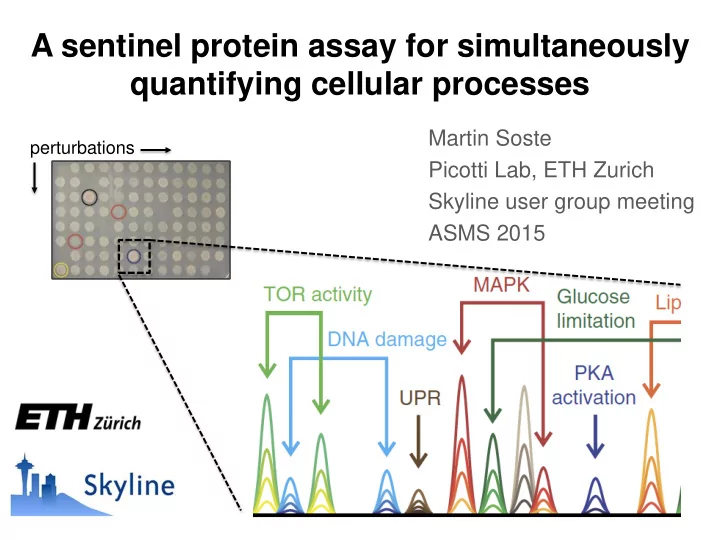

A sentinel protein assay for simultaneously quantifying cellular processes Martin Soste perturbations Picotti Lab, ETH Zurich Skyline user group meeting ASMS 2015
α -Synuclein induced cytotoxicity 1 copy α -Syn 2 copies α -Syn Established model for protein aggregation disease collaboration with Lindquist lab
100 protective genes α -Syn + gene n Genetic modulator ( 1…100) Rescue α -Syn α -Syn gene n What are the genetic modulators doing to rescue the yeast? Willingham et al. Science. 2003 Cooper et al. Science. 2006 Gitler et al. Nat Genet. 2009 Yeger-Lotem et al. Nat Genet. 2009
How to find activated processes? effects of 100 genes, triplicates = 300 samples Omics Targeted proteomics Cell biology & biochemistry Intensity RT . . . Intensity RT . . . functional activity unbiased quantitative x not necessarily x time and labour x biased activity x not necessarily activity
Methodological aim unbiased screening for activity with targeted proteomics unbiased functional activity quantitative Intensity Marker proteins Retention time
The sentinel protein assay A fingerprint for activity gene Effectors of protective genes? α -Syn n
Sentinels: Markers that report cellular process activation Sentinels are proteins, phosphorylation sites or degradation products
Example: phosphorylation-based sentinels
Example: MAPK activation
Identified functionally validated sentinels SENTINEL TYPE MODULE / PATHWA WAY DETAILS ATG1 P-site AUTOPHAGY ACTIVATION Phosphorylated/dephosphorylated upon autophagy activation/deactivation ATG13 P-site AUTOPHAGY ACTIVATION Phosphorylated/dephosphorylated upon autophagy activation/deactivation Fingerprint IRE1 P-site UNFOLDED PROTEIN RESPONSE Autophosphorylated in UPR HOG1 P-site MAPK SIGNALING Phosphorylation activates signaling FUS3 assay: P-site MAPK SIGNALING Phosphorylation activates signaling SLT2 P-site MAPK SIGNALING Phosphorylation activates signaling CKI1 P-site LIPID SYNTHESIS Phosphorylation by PKA regulates phosphatidylcholine synthesis - 157 MAF1 P-site TOR SIGNALING Phosphorylated by PKA in a TORC1-dependent manner SCH9 P-site TOR SIGNALING Phosphorylated by TORC1-complex proteins YPK1 P-site TOR SIGNALING Phosphorylated by TORC2-complex IGO1 P-site RIM15 - KINASE ACTIVITY Phosphorylated by RIM15 - 152 P-sites MIG1 P-site GLUCOSE REPRESSION Phosphorylated by Hxk2 (glucose repression/deprepression) Proteotypic peptides SUI2 P-site TRANSLATION Phosphorylated when inhibition of translation initiation is required DUN1 P-site DNA DAMAGE Phosphorylated in response to DNA damage. PROT – 300, PHOS – 152 SLX4 P-site DNA DAMAGE Phosphorylated by ATR and ATM upon DNA damage SRM assays Top 3 – 6 transitions TLG1 P-site TPK1 - KINASE ACTIVITY Phosphorylated TPK1 and dephosphorylated by SIT4 TLG1 P-site SIT4 - PHOSPHATASE ACTIVITY Phosphorylated TPK1 and dephosphorylated by SIT5 PROT – 1174, PHOS – 807 SIP1 P-site SNF1 - KINASE ACTIVITY Phosphorylated by SNF1. CTK1 P-site CAK1 - KINASE ACTIVITY Phosphorylated by CAK1 iRT-based scheduling ADR1 P-site PKA - KINASE ACTIVITY Phosphorylation by PKA SEC63 P-site CK2 - KINASE ACTIVITY Phosphorylated by casein kinase II CDC23 P-site CELL CYCLE Phosphorylated by CDC28 --> early mitotic activity Synthetic heavy peptide confirmation CDC24 P-site CDC28 - KINASE ACTIVITY Phosphorylation by CDC28 activates early mitotic activity CDH1 P-site CELL CYCLE Phosphorylated by CDC28, in S, G2 and M phase CDH1 P-site CDC28 - KINASE ACTIVITY Phosphorylated by CDC28, in S, G2 and M phase 188 Bcy1 P-site YAK1 - KINASE ACTIVITY Phosphorylated by YAK1 in response to glucose starvation. YPK1 P-site PKH1 - KINASE ACTIVITY Phosphorylated by Pkh1 NPR1 P-site NITROGEN METABOLISM Dephosphorylated upon nitrogen limitation processes RCK2 P-site HOG1 - KINASE ACTIVITY Phosphorylated by HOG1 after osmotic stress. (…..) (…..) (…..)
Testing the sentinel protein assay “Sentinel Fingerprints” Well-characterized Control perturbations Osmo-stress Osmo-stress adapted Heat shock Rapamycin Heat-shock recov. AA/N starvation Rapamycin Stationary phase AA/N starvation Heat shock 30 min Heat shock 60 min Osmo-stress Heat shock recovery Osmo-stress adapt. Quiescence Multi-peptide chromatograms
Validation from expected responses HS30 HS60 HSR OS OSA SP SP SP
Simultaneous and large-scale coverage Snapshots of yeast physiology Report of 202 markers for activity Success rate = 74% = detected, not regulated Soste et al. Nat Methods. 2014 = not detected
Novel responses in stationary phase Coordinated response of HSPs Concentration of cytosol Subset of heat-shock proteins up Typical markers of heat-shock down Water deficiency marker up
Summary: sentinel assay Advantages: Captures behaviour of many pathways Probes activation, not merely abundance Targeted yet unbiased (“discovery SRM”) Fast and interpretable readout of cell status Apply to any perturbation of yeast (e.g. large set of genetic manipulations or drugs) Limits: Cannot identify a perturbed pathway if a marker is not included Influence of pathway crosstalk
Outlook: fingerprints of rescue from α -Syn Protective genes (~100) Multivariate regression 120 Sentinels Biomass (scattered light) 100 80 60 40 20 0 0 10 20 30 Time (hr.) Vector aSyn aSyn+UBP7 aSyn+PPZ2 aSyn+YPT1 aSyn+YKT6 aSyn+YPK9 aSyn+NTH1 aSyn+IME2 aSyn+NVJ1 gene α -Syn n Identify key processes in rescue Modulate key processes in higher organism models of α -Syn toxicity
Acknowledgements Supervisor α -Syn model Paola Picotti Susan Lindquist, WIBR Gabriela Caraveo, WIBR Picotti Lab Andre Melnik Sentinel Prediction Yuehan Feng Stefanie Wanka, UZH Juan Gerez Christian Von Mering, UZH Rita Hrabakova Data analysis Paul Boersema Andreas Beyer, Sybacol Pascal Leuenberger Ilaria Piazza Picture on title slide Simone Schopper from Cooper et al. 2006 Natalia Prymaczok Marco Tognetti Thank you to Brendan, the development team and the user community! martin.soste@bc.biol.ethz.ch
Recommend
More recommend